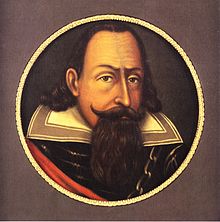|
Philip II, Duke of Pomerania
Philip II, Duke of Pomerania-Stettin (29 July 1573 – 3 February 1618) was from 1606 to 1618 the reigning duke of Pomerania-Stettin and is considered to be among of the most artistic of the Pomeranian dukes. He married Sophia of Schleswig-Holstein-Sonderburg (1579-1618) in 1607. The marriage remained childless. LifePhilipp was born on 29 July 1573 in Neuenkamp, which later became Franzburg in Pomerania, as the eldest son of Duke Bogislaw XIII of Pomerania-Barth and his first wife, Clara of Brunswick. He grew up in his father's small residence in Barth. Although he was the second-born son of Duke Philip I of Pomerania-Wolgast, when Philip I's inheritance was divided among the Pomeranian dukes on 1569, waived his rights to a share, in favour of his younger brother Ernest Louis. He had been compensation with an apanage consisting of the district of Barth and the secularized Cistercian monastery at Neuenkamp. As a child and teenager, Philip received the usual education for a son of a German prince during the late Renaissance era. Soon, however, his artistic and scientific interests grew soon beyond the usual level. Even at the age of twelve, he owned a collection of books and pictures. He wrote his first scientific papers at the age of 17. His art was not just an expression of his royal representation, but emerged from an inner need. At age 18, he wrote: It is may pleasure to collect good, selected books, portraits from a master's hand, and ancient coins of all kinds. From these I learn how to improve myself and also how I can be beneficial to the general public. According to the customs of his time he undertook numerous grand tours, which led him to many European countries and the local courts. The two-year stay in Italy at the end of his final grand tour, was cut short in 1598 when his mother fell seriously ill. Five years later, government business caught up with him. In 1603, Duke Barnim X had died and Philip's father, Bogislaw XIII, became the ruling duke in the Teilherzogtum of Pomerania-Stettin. Apparently, Bogislaw XIII felt he was too old to actually govern, so he appointed his son Philip II as governor of Pomerania-Stettin. When Bogislaw XIII died in 1606, Philip became the ruling duke in Stettin in his own right. Characteristic elements of his reign were his patronage of the arts (described in more detail below), but also his rural regulations of 1616, in which a legal basis for serfdom was created. On 10 March 1607 he married Sophia (1579–1658, in Treptow an der Rega, her dower), daughter of John II, Duke of Schleswig-Holstein-Sonderburg and his first wife Elisabeth of Brunswick-Grubenhagen.[1] The marriage was, however, childless, like all the marriages in the last generation of the Dukes of Pomerania, so after the death of Philip's brother Bogislaw XIV, the House of Griffins died out in the male line. Philip's special penchant for melancholy became apparent early on and was certainly reinforced by his sickly constitution. From the first decade of the 17th-century, he suffered from gout. This made life more difficult, and he withdrew more and more from public life. It prevented him from attending in person the wedding of his brother Francis with Sophia of Saxony in Dresden in 1610, and the investiture of Emperor Matthias at the Diet of Regensburg in 1613. In 1612, he visited a recently discovered health spa in Lüneburg, but it brought him no relief from his suffering. He died on 3 February [O.S. 13 February] 1618, before the age of 50, like most male members of the last generation of the House of Griffins. Funding the artsThe most important works of art commissioned by Philip II date from the period 1606–1618. They include:
The art dealer Philip Hainhofer from Augsburg was responsible for the procurement of many works of art. Philip corresponded extensively with him. During Hainhofer's visit to Pomerania in 1617, he kept a diary. This diary contains a detailed description of the art collection at the Ducal Castle in Szczecin. When Philip died in 1618, many of the works he had commissioned had not been completed. His brother and successor, Duke Francis, showed little inclination to continue his deceased brother's artistic ambitions. He paid for the completion of works commissioned by his brother, but after that the era of art at the court of the Pomeranian Dukes came to an end. Among the works completed under Francis was a new wing of the Ducal Castle on the west side of Mint Square. Most works of art were housed in this new wing. AncestorsNotes
References and sources
External links |
||||||||||||||||
Portal di Ensiklopedia Dunia
